
Publications The Power Of Alliances: Partnering For Growth In The Insurance Sector
- Publications
The Power Of Alliances: Partnering For Growth In The Insurance Sector
- Christopher Kummer

SHARE:
By KPMG
Contributors: Simon Phipps, Ellie Barlow, Martin Blake, Sheel Gill, Ram Menon, Craig Mennie, Benjamin Tarac, Vivek Aranha, Wei Keat Ng
Foreword
This is an era of unprecedented change for the insurance sector. New technologies, new customer expectations, new regulations and new competitive pressures are rapidly disrupting the traditional insurance business model. In this environment, insurance organizations have no choice but to adapt.
The good news is that the vast majority of insurance executives intuitively know they need to be more innovative. In fact, according to a recent report by KPMG International, more than 80 percent of insurance execs now draw a direct correlation between their organizations ability to innovate and its future success.
At the same time, insurers are increasingly starting to recognize that their current organizational structure and culture may not be conducive to achieving the type of real, sustainable and value-creating change and innovation needed to compete in this new world. New models, new ideas and new partners must be found. Executives are starting to recognize the power of alliances.
Yet our experience and our data suggest that insurance organizations are struggling to create the types of dynamic business models they need in order to survive and thrive in this new environment. The complexities are significant: issues related to control, culture and intellectual property must be balanced against considerations such as cost, resources and risk; customer preferences must be balanced against regulatory restrictions; and future growth opportunity must be balanced against short-term profit requirements.
As this report illustrates, there is no ‘one-size-fits-all’ approach to partnering for growth and each situation will be unique. Rather, insurers will need to learn from their experiences, peers and competitors as they strive to harness the power of potential alliances.
Recognizing this, we bring together key lessons and experiences from past and present partnerships in the sector. To provide a wide scope of reference, we have explored three main areas where insurers have been particularly active: bancassurance, Financial Technology (FinTech) and digital or non-traditional distribution channels. Each provides keen insights to help insurers create more sustainable and value-driven partnerships and alliances. (Gary Reader, Head of Global Insurance KPMG International)
An appetite for alliances
Partnerships preferred
Nearly 70 percent of insurers now believe that partnerships, not in-house efforts will characterize the future of innovation for their organization.
In today’s rapidly-changing and complex competitive environment, the need for new ideas, new skills and new opportunities is obvious. As one global reinsurer noted in a recent KPMG report, “We can’t wait for the structural changes to occur before we start moving; we need to address these changes now if we hope to offer the business new growth opportunities over the next 5 years”.
At the same time, the majority of insurance executives also recognize that – while some change can be catalyzed from within – the greatest opportunities will likely come from outside of the organization. Almost three-quarters of insurance executives say that they lack the internal core skills needed to drive innovation.
Not surprisingly, some are taking the well-trodden path of acquisition and integration. Aetna’s purchase of BSwift (a private health insurance exchange platform in the US) allowed Aetna to capture market share through a new distribution platform. Generali’s purchase of the UK telematics firm MyDrive Solutions shows that strategic acquisitions in the Financial Technology sector can support a broader growth strategy.
But the reality is, there are significant risks associated with an M&A strategy. And with so much change still underway across the market, not all executives seem willing to put all their eggs in one basket by spending their war chests on a major purchase.
In any case, outright acquisition of capabilities, customers or technologies is not always the right option.
As a result, insurers are now increasingly focused on creating alliances and partnerships to drive new growth, create new channels and drive new innovation. In fact, our report A New World of Opportunity: The Insurance Innovation Imperative found that 43 percent of insurance organizations have already developed partnerships with academics and other third parties. More than a third have developed innovation hubs or labs to ‘incubate’ new ideas for their organization or group.
However, our experience suggests that few insurers have yet to find a ‘winning formula’ for successful partnerships in the insurance sector. And, as a result, most are now looking for new approaches and new models that can help them drive real and sustainable value from their partnerships and alliances.
“There is no doubt in my mind that the future will be won on the basis of the alliances, partnerships and joint ventures formed by insurance companies today. Anyone that thinks they can survive on their own in this environment is fooling themselves.” – Gary Reader, Head of Global Insurance, KPMG International

Learning from experience: Lessons from the sector
“Striking a new partnership needn’t mean starting from scratch. It’s about learning from both traditional competitors and new disruptors. And it’s about shamelessly borrowing best practices and new ideas from outside the insurance sector and its traditional allies.” – Gary Reader, KPMG’s Head of Global Insurance
Creating successful alliances and partnerships in the insurance sector is not easy. While there is no clear-cut approach to creating valuable and sustainable relationships, there is significant precedent to learn from.
The bancassurance sector provides particularly rich insight. Indeed, with more than 30 years of experience around the world, partnership and alliance models in the bancassurance sector are fairly well understood. Yet challenges still often emerge in this intricate relationship between banks and insurance companies.
Insurers can learn from the sector’s deep experience creating partnerships and alliances around new distribution channels. Having learned (and in some cases been burned) by previous distribution agreements, many are starting to rethink their approach as they begin to target new markets, customer groups and emerging channels.
And while the depth of experience may not be as rich, insurers can also benefit from examining the wave of recent deals, alliances and partnerships between insurers and the Financial Technology and Insurance Technology sectors (referred to jointly as FinTech). Fast-paced and often somewhat speculative, these arrangements represent the ‘cutting edge’ of alliances and partnerships in the industry.
In the following chapters, we explore the experiences and lessons learned from insurance organizations as they construct, execute, manage and exit partnerships and alliances across new distribution channels, bancassurance and FinTech. We believe that – taken as a whole – these insights provide a clear picture of some of the major challenges, opportunities and considerations facing today’s insurance organizations.
Dating, marriage and sometimes divorce: Bancassurance creates new relationships
“Insurers and banks have been working together for years developing and evolving bancassurance models. With whole-scale change around the corner for both parts of the financial services sector, to survive and thrive they now need to take what they have learned and adapt and evolve quicker and better than ever before.” – Simon Phipps, Partner, KPMG in Hong Kong
Introduced in Europe in the late 1970s, the relationship between banks and insurers – widely known as bancassurance – is often an attractive proposition for both insurers and their banking partners.
Bancassurance has long been a fruitful area for partnerships as the synergies between banks and insurers are often very clear. Banks bring to the table customer connectivity by virtue of the frequency and quality of the customer data they manage. Insurers, on the other hand, bring specialized skills in areas such as insurance design, manufacturing and distribution.
Not surprisingly, the number of bancassurance agreements in place around the world has grown dramatically since inception and adoption is only expected to increase as new and emerging markets start to focus on improving access to insurance and banking services. Bancassurance already attracts some of the biggest players in the marketplace, largely because of the allure of a strategic win-win, faster growth and scale economies.
Insurers see bancassurance agreements as a way to quickly enhance their distribution reach while taking advantage of increased economies of scale. Banks, on the other hand, see these agreements as an opportunity to offer a deeper variety of products to their customers while capturing commissions, fees and (often sizable) upfront contract payments from the insurer.
A marriage made in heaven?
There is no single winning formula for successful bancassurance relationships and the nature of these alliances often varies significantly. Much like relationships in our personal lives, the degree of commitment between the parties often depends on the strength of the relationship and the perceived benefits.
In some cases, banks and insurers have entered into simple ‘non-strategic partnerships’ in which banks work with multiple insurers with no long-term commitment on either side (akin to being single and dating). Others have struck medium-term ‘strategic partnerships’ using vehicles such as Distribution Agreements (think ‘courtship’ or ‘engagement’), while those not shy of commitment have essentially married their partner through long-term joint venture (JV) partnerships.
However, like most relationships, the dynamic between banks and insurers can be strained at times and, without constant effort and investment from both sides, can result in one or both parties feeling unfulfilled by the relationship. And, unfortunately, a significant number of these partnerships tend to end in ‘divorce’, without much value to show at the end – other than lessons learned for the next partnership attempt.
Understanding your objectives
One of the biggest reasons for bancassurance ‘divorces’ comes down to a lack of recognition of the needs of the other party. The reality is that – while banks and insurers may seem very similar with clear synergies – each party has very different (and often directly conflicting) objectives.
Simply put, insurers are primarily focused on value-creation by monetizing risk management over time, while banks are focused on driving value-creation through the selling of shorter-term traditional banking products across an often stable and loyal customer base.
This often creates tension in the partnership, with the insurer wanting to develop and deploy products that create long-term economic value for shareholders, while the bank is looking to generate commission revenues from competitive products that can sell fairly easily in the shorter-term.
At the same time, competition for ‘shelf-space’ at bank branches is intense, with insurance typically one of 15 to 20 products sold by bank relationship managers. These managers are looking for products that are highly competitive and, as a result, tend to expect the insurers to absorb some level of margin compression.
As a result there is often a misalignment of objectives that – unless expressly recognized when developing the agreement – can lead to missed expectations and, potentially, divorce. To accommodate this difference in outlook, insurers often try to incorporate ‘profit share’ agreements into their partnership terms with banks to align interests between short- and longer-term results.
Regulation is also changing the dynamic, with banks becoming responsible for the sale of insurance products and therefore liable for potential mis-selling exposure. This is true in mature markets but also expanding into high growth markets, for example, with recent legislation in India. These developments should help the positive development of the insurance sector and also better align the interests of banks and insurers over the longer term.
Creating the right operating model
A review of the more successful bancassurance agreements shows that it takes more than goodwill and an alignment of objectives to build a healthy relationship. It also takes clear rules of engagement; in other words, a transparent, practical and mutually-beneficial operating model.
Key questions will need to be answered across a number of areas:
• Partnership strategy: How does the partnership align to the group’s corporate strategy and what level of integration will be required to achieve success?
• Product offering: Will the insurer offer their traditional product portfolio, create a new portfolio of bancassurance products tailored to the bank, or a combination of both?
• Branding: What role will the insurers’ brand play in the sales channel or will a new ‘co-brand’ be created?
• Sales channel: Will the sales channel be managed by bank staff only or will insurance agents – embedded or via referrals – play a role?
• Sales approach: Will sales representatives be opportunistic, responsive or proactive when selling the products?
• Operating platform: Will the partnership require a standalone IT platform or will it be integrated into the banks’ and insurers’ IT systems?
Critical success factors
Ultimately, the past four decades of experience with bancassurance has demonstrated that – even with the best partnership agreements and well-planned operating models – success always comes down to execution.
At KPMG International, we have identified five critical success factors that tend to characterize the most successful bancassurance relationships, see chart below.
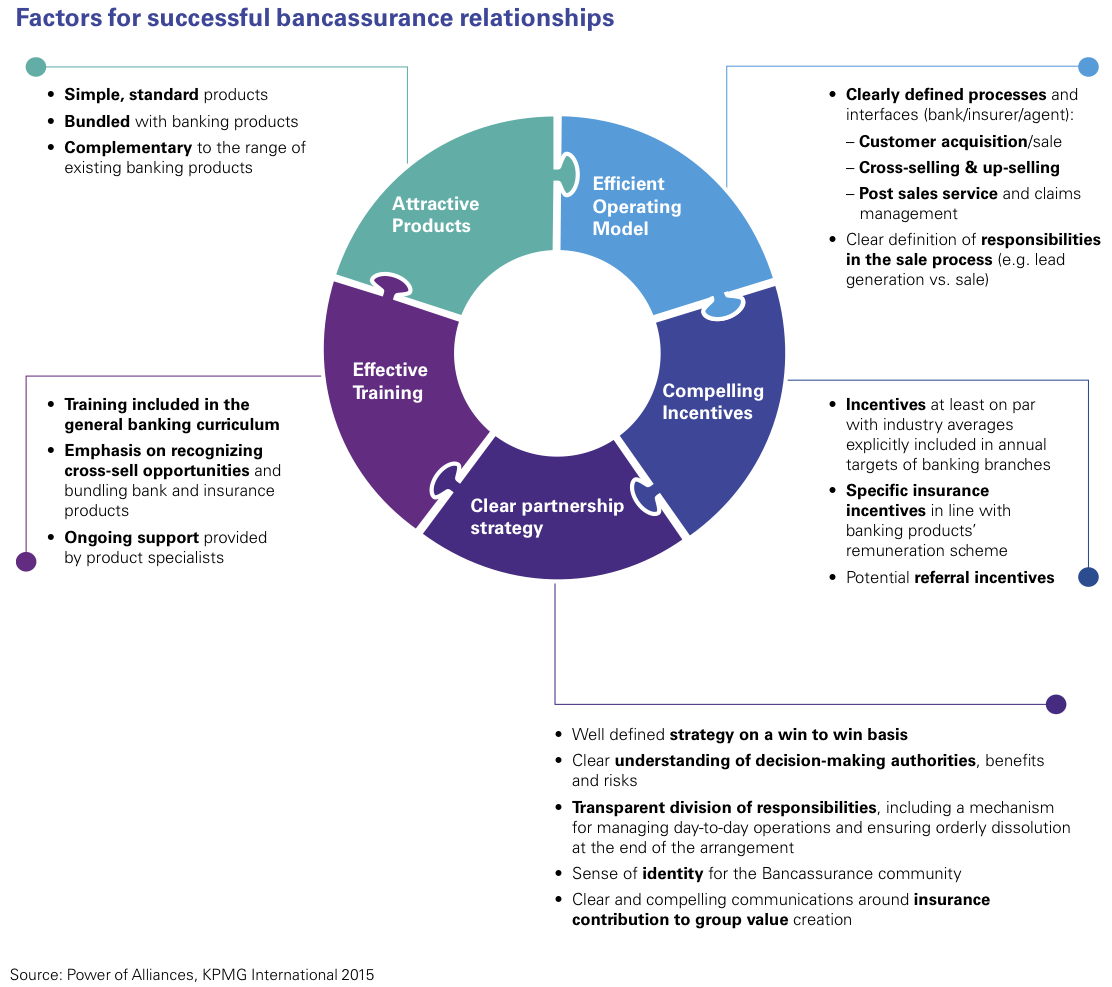
5 key takeaways
1. Keep your eyes wide open: Take the time to fully understand the objectives, motivations and exit strategy of your partners before getting into the details.
2. Assess the value: Ensure that the partnership aligns to – and helps advance – your corporate and growth objectives.
3. Understand your willingness to commit: While long-term tie-ups can lock down competitive advantages, they can also lead to long-term challenges.
4. Think through the operational considerations: Carefully consider how the relationship will operate at a functional level and what governance and operating models will be required to support that.
5. Consider the critical success factors: Understand what it takes to sustain a mutually beneficial relationship over the long-term.
A deeper look: Bancassurance around the world
The bancassurance model has not developed consistently around the world. Indeed, its success often depends on a number of external factors such as tax, regulation, banking penetration and often even local custom. As insurers look for new growth opportunities in untapped markets, these differences will play a key role in the way partnerships are developed.
Asia Pacific
The Asia Pacific bancassurance market is expected to enjoy significant levels of growth (a CAGR of 8.13 percent from 2013 to 2018), spurred by positive macro-economic trends and rising affluence. Not surprisingly, there is already significant competition for bancassurance partnerships in the region.
Indeed, by late 2014, of the top 150 banking groups in Asia Pacific, MetLife had already penned almost 50 different bancassurance partnerships.Together, the top five insurers had locked away almost 200 partnerships in the region, with banks tying up with multiple insurers in countries where regulations permit.
Adoption of bancassurance has been uneven across the various markets. In South Korea and Hong Kong, for example, bancassurance holds more than a 50 percent share of total life insurance premiums. In Japan and Vietnam, it commands less than 10 percent of the market.
Much like other regions, regulation plays a key role in the development of the various markets. In India, for example, the government is looking to quickly increase insurance penetration and the insurance regulator (the IRDAI) is now hoping to open the market further by allowing banks to tie up with and sell products from multiple insurers (3 Life, 3 General and 3 Health Insurers). Previously, banks were allowed to tie up with only one insurer in each segment or had to acquire a broking license to be able to tie up with multiple insurers.
In China, the implementation of two regulations – Regulation No. 3 and Regulation No. 12 – have created some limitations on the development of bancassurance partnerships. Regulation No. 3, for example, explicitly requires insurers and banks to develop risk-protected and long-term saving insurance products and to work with no more than three insurers at each outlet. Regulation No. 12 deals with issues such as solvency ratios, sales fees, the matching of the premium size and the required capital strength for high cash value insurance products.
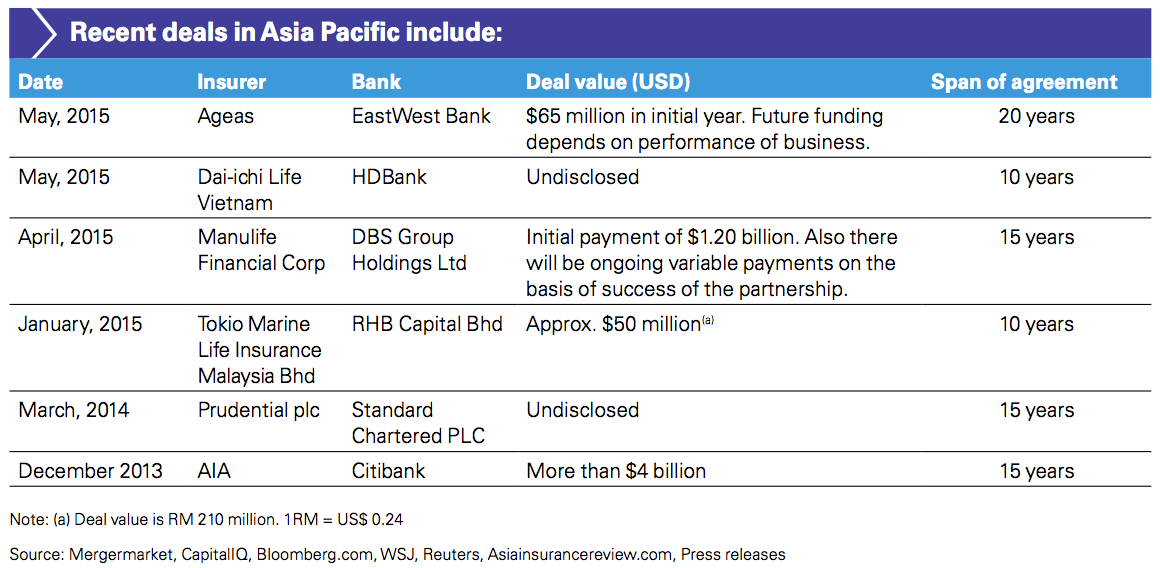

Europe
While Europe is the birthplace of bancassurance (France introduced the first simple bank distribution models in the 1970s), adoption has been somewhat varied across the region.
In some markets, such as Turkey, Portugal, Italy and Spain, bancassurance is the dominant model, capturing close to 70 percent of life insurance premiums. But in the UK, Belgium and Austria, traditional agents and brokers remain the dominant distribution channel. And in Germany, bancassurance growth is restricted by regulation.
However, the market still shows strong signs of growth and is expected to enjoy a CAGR of more than 6 percent between 2013 and 2018 to reach a height of almost US$200 billion.
In part, this is because insurance penetration remains low in many European countries – Life insurance penetration in Spain and Italy is 5.2 percent and 7.6 percent respectively, compared to 12.2 percent and 10.7 percent in the UK and US, according to OECD stats. And less than a quarter of bank customers in Italy (28 percent of those in Spain) currently hold a life insurance policy. Clearly, there is significant room for growth in some markets.
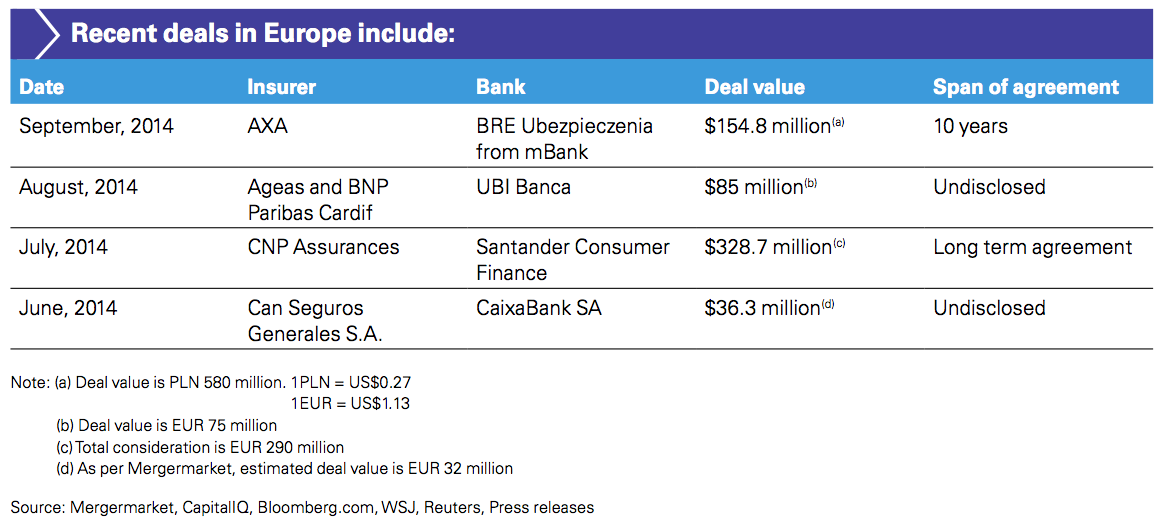

Africa and the Middle East
The past few years have brought increased attention to these regions from major insurance players around the world. Rapid economic growth, emerging middle classes and improving regulatory environments are all contributing to an uptick in activity across both Sub-Sahara Africa and the Middle East.
In Africa, banks have seen significant growth in insurance sales through the bundling of products. According to a report by Finaccord, approximately 90 percent of mortgages and personal loans are bundled with credit life insurance policies. Additionally, household insurance and personal automobile insurance are also commonly bundled with lending products.
However, the development of the channel is still at very early stages in many countries. The opportunity is huge, particularly when linked to growth of mobile banking (see case study below).
The Middle East also shows significant potential for bancassurance growth. Unlike other regions, there are few restrictions preventing banks from selling insurance products and, currently, life insurance penetration is very low (the average penetration is less than 1 percent). Given that in the UAE almost 40 percent of all premiums earned by insurers come through the bancassurance channel, it seems clear that customers in the region are open to the model.
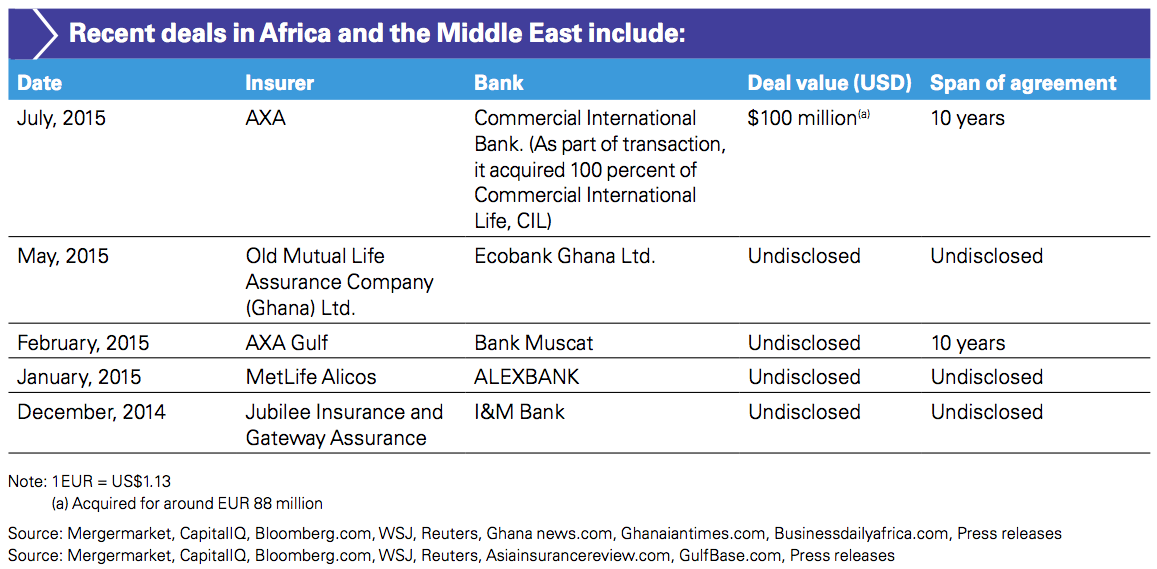
North America
In the North America region, both the US and Canada have very low bancassurance penetration and struggle to grow.
While, in the US, the financial structure was deregulated through the Gramm-Leach-Bliley (GLB) legislation in 1999, it seems clear that customers continue to prefer the more established channels such as agents and brokers.
The sector has seen stuttering growth since deregulation. Between 2012 and 2013, the value of life insurance premiums sold through banks plummeted by around 27 percent, according to the Bank Insurance and Securities Research Institute (BISRA). And most believe that the next 2 years will bring more difficult times for the bancassurance sector in North America with forecasters suggesting that the market may contract in 2016 and 2017.
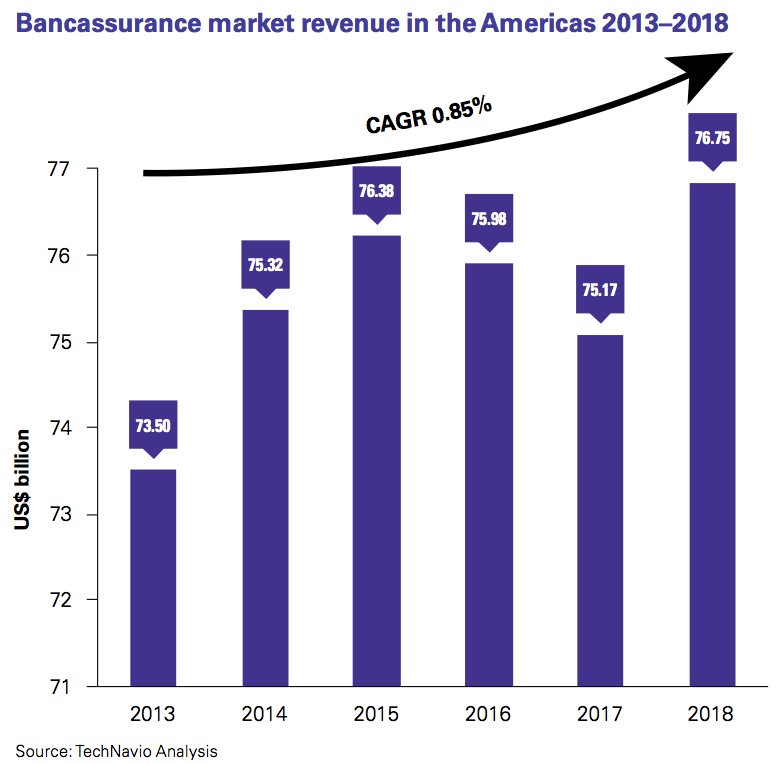
South America
While the market may be stagnant in North America, the channel has been enthusiastically adopted in many South American countries. In Brazil, for example, bancassurance accounts for around 80 percent of life insurance premiums. In Mexico, bancassurance represented 41 percent of total sales in 2012 and it widely considered to have grown since then.
In part, this growth is due to favorable regulatory landscapes in both Brazil and Mexico. But it has also been encouraged by the prevalence of large foreign players who are leveraging partnerships with large banking groups to develop new bancassurance channels.
Significant deals have been struck including the Joint Venture between Banco do Brasil and global insurer Mapfre; the purchase of a 30 percent stake in Porto Seguro by Itau and; the long-term distribution agreement struck between Banco Santander and Zurich Insurance Group. And, to date, it seems that these major deals have helped these large Brazilian banks increase their earnings.
Case study: Selecting the right markets for growth
Not all markets offer the same growth potential and ease of entry. Those who go to market hoping that one ‘international’ strategy will fit all situations will almost certainly end up disappointed.
When one Fortune 100 multinational insurer wanted to expand their footprint, they knew they needed to start with a clear understanding of the opportunities and risks inherent in each market.
Working with KPMG in the US – and supported by several member firms of KPMG International – the insurer hoped that the project would help identify and assess the potential strategic growth opportunities in specific market segments.
Following a thorough analysis of market and competitive intelligence in the Americas, Asia Pacific, Middle East, Africa and Europe, the team developed a detailed strategic analysis framework to evaluate specific market segments. Each geography and market was prioritized based on criteria such as macro-economic indicators, market size, growth trends, future growth potential, drivers of growth and profitability, competitive environment, regulatory environment and likely ease of market entry.
Based on the team’s findings, the insurer was able to develop and execute on a new international strategy that leveraged their core strengths and key market insights to drive new growth.
Market Spotlight: China – bancassurance sees significant growth
Growth, competition and innovation all seem to be hallmarks of China’s bancassurance market.
However, China’s bancassurance market also faces significant challenges and growing pains. Issues related to fierce competition, constantly-evolving regulations and significant variations in market dynamics are all accentuated by product offerings that may not suit the long-term needs of consumers and divergent objectives of key banks and insurers.
Generally speaking, current bancassurance products are savings-oriented with simple design structures that are widely accepted by Chinese customers. Selling the more profitable risk-oriented products is typically more difficult, although now being driven by legislation
What’s driving the market?
As in other markets, the increasing internet penetration and rapid adoption of smartphones, tablets and social media by China’s consumers has transformed entire sectors of the economy. And, for the most part, digital disruption is being embraced, enabled and monetized by insurers.
China’s players recognize that opportunities are bound to deliver digital innovation across the insurance value chain, from policy purchase and claims management to after-sales service. And they recognize the value that these channels provide to their bank partners, offering more personalized interactions and resulting in better cross-sell, higher customer satisfaction and improved retention. This, in turn, will translate into better connectivity between banks’ and insurers’ systems, allowing improved information sharing and greater depth and quality of information captured.
Looking ahead
Positive macroeconomic and social factors will drive reform in the medium-term. The ageing population and concern over the adequacy of the safety net provided by the health system will create significant additional demand for insurance. However, many insurers are now questioning their prospects in China and rethinking how to implement a profitable bancassurance strategy.
Despite these challenges, there is cause for optimism across the market due to the expansion of foreign insurance players and the growth of banks’ product portfolios. A relationship-based service, willingness and capability to invest in understanding the clients’ needs and an ability to embrace the digital revolution will be the critical steps for success in bancassurance distribution across China.
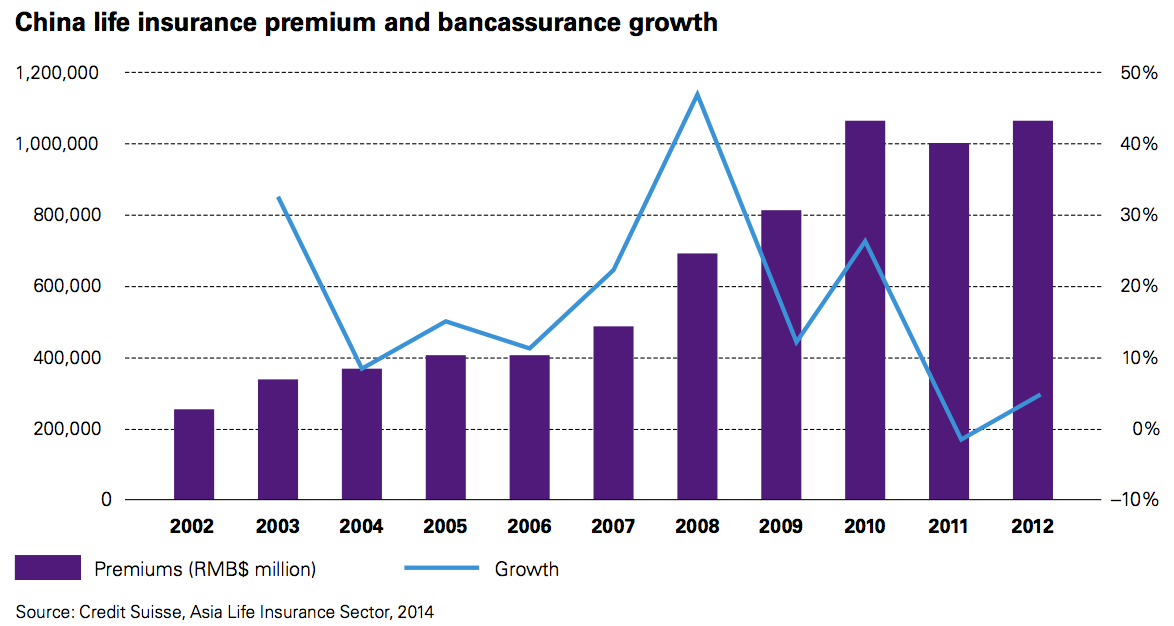
Market Spotlight: Australia – an evolving established market
Largely dominated by four large domestic banks, a bank insurer and one large life company, the Australian life insurance market is clearly led by the bancassurance channel. But while the market seems fairly stable for now, there are signs that disruption – largely on the back of regulation – may fundamentally change the Australian bancassurance market and create new opportunities for foreign and local players.
The banks’ dominance of the insurance industry stems from a shift in the model in the 1990s which led the largest banks to acquire significant fund management and life insurance businesses to complement their existing products. As a result, the bancassurance model in Australia tends to focus on the bank-life insurance crossover market, in which various bank distribution channels (including arrangements with third-party aligned financial advice groups, bank-owned financial planning networks, bank branches and direct solutions through traditional call centers and inbound web sites) combine to create a competitive advantage.
Life insurance is still predominantly coupled with wealth management products for both retail and corporate customers but is increasingly being sold together with lending products (consumer credit insurance) and through direct channels, which have lower distribution costs and generally higher returns compared to traditional channels.
What’s driving the market?
While Australia’s bancassurance market seems fairly stable, there are a number of trends that may significantly impact the sector in the future.
The introduction of the recent conglomerate capital standard for banks in Australia, for example, is expected to have a potentially significant impact on the capital required to be held for life insurance businesses.This, in turn, is having a direct impact on the return on capital that can be achieved by the banks. Many of the life insurance businesses achieve mid-to-high single digit ROEs, whereas the big banks in Australia target mid-teen ROEs which ultimately results in ROE drag for the Group.
The impact of conduct risk reviews and the trend toward simplifying corporate structures may also create additional pressures (albeit recognizing that, in the long run, simplified structures should have a positive regulatory impact). Banks also face capital pressures in their own business from Basel III rules and additional local APRA regulatory imposts, which are sharpening the focus on capital management and efficiency.
Looking ahead
Depending on how the rules are applied, some banks may decide to sharpen their focus onto high ROE segments which, inevitably, will lead to portfolio rationalization. Others may decide to recalibrate and reduce return expectations to reflect global levels.
In either case, it is likely that the current trends in the bancassurance market in Australia will help diversify the business models of the large players, as strategies evolve and participants assess the best models going forward.
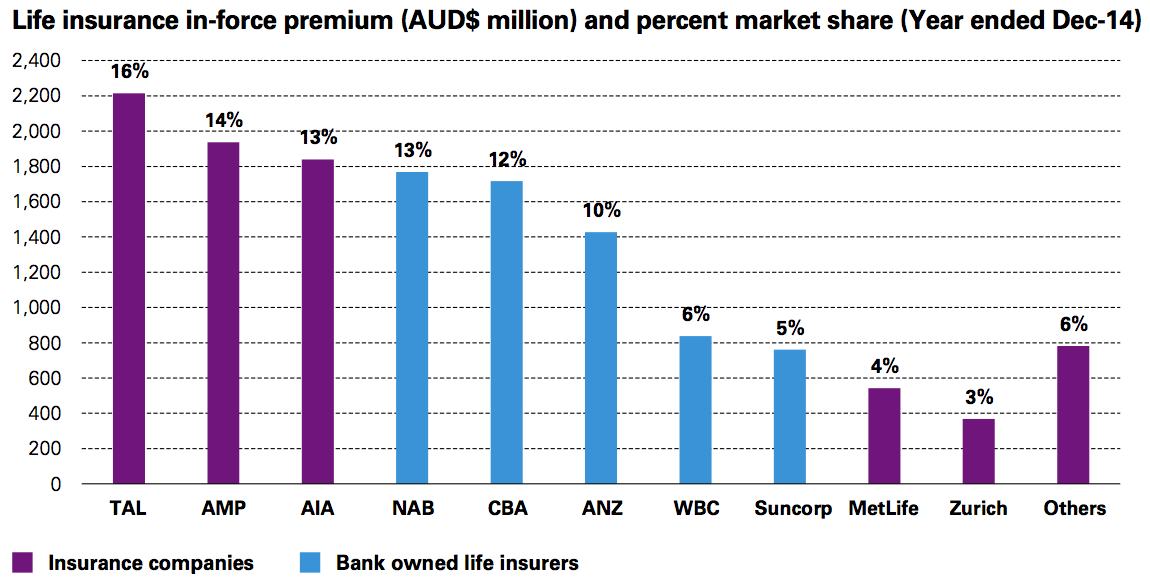
Market Spotlight: France – continued growth in a mature market
As the pioneers of bancassurance, it is perhaps not surprising that the channel holds a dominant position (more than 60 percent) in the life insurance market in France and a growing proportion of the property and casualty market.
Overall bancassurance in France is well-established and mature. The past four decades have seen participants develop different retail models that often depend on the level of development of the entity (with respect to the product mix and the nature of the insurer’s role).
Retail sales networks have been extensively trained in the insurance business and banks have largely focused development on simple, easier to sell insurance products that are often viewed by clients as a savings product more than insurance.
However, with the large number of banking, non-life and life insurance products to promote, some insurers (such as BNP Paribas) have added their own sales workforce to support the retail banking network, thereby enabling the promotion of a more sophisticated range of products such as unit-linked.
What’s driving the market?
Changes in regulation and new consumer protection legislation are creating some new activity in bancassurance. For example, the Hamon Law, adopted by France’s parliament in early 2014, enables policy holders to terminate their policies at any point after one year. Clearly, this has the potential to increase the customer churn rate for insurance as customers start to shop around.
The potential for new growth is also driving new activity in the market with the latest Accord National Interprofessionnel (ANI), struck between unions and employers associations in 2013, requiring all employers to provide supplemental health insurance to their employees by January 1, 2016. The move is widely expected to drive growth across the sector and further supports the general bancassurance trend toward a greater focus on professional and corporate clients in France.
Looking ahead
In a market where large retail networks and close customer relationships are the two competitive differentiators for bancassurers, organizations will need to carefully consider the evolution of their retail network and, in particular, the growing impact of new technologies on customers’ behaviors and buying processes. This will require banks to start seriously considering how they might better integrate their insurance channels into their digital banking projects and planning.
However, continued growth and activity in the market may largely depend on the regulatory environment as insurers continue to digest the requirements of Solvency II and banks continue to align to the demands of Basel III. Current transitionary arrangements – such as the so-called ‘Danish Compromise’ for Basel III (which gives banks’ insurance activities a risk weight of 370 percent instead of an equity deduction on regulatory capital) – will end in 2021, creating future uncertainty for the market.
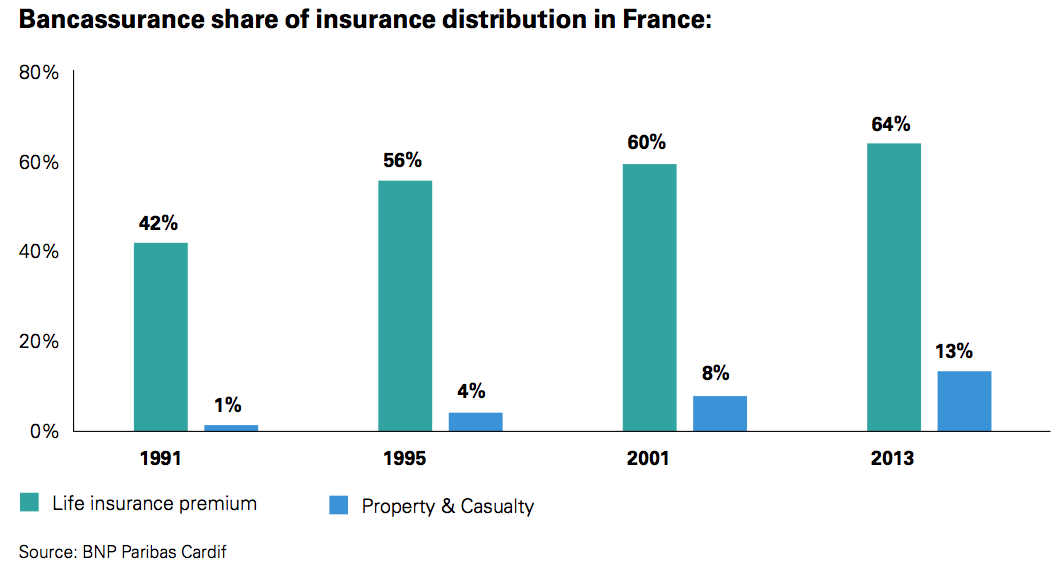
Own it, lease it or share it? FinTech provides lessons in fast-paced partnerships
“Creating partnerships and alliances in the FinTech sector has all the thrills and spills of a rollercoaster ride. But for those with the right attitude and safety precautions, it can be exhilarating and well worth the ride.” – Martin Blake, Partner and Chairman NSW, KPMG in Australia
Over the past 2 years, FinTech has emerged as one of the most active deal arenas for insurers around the world. Competition for the latest financial services technologies has become fierce. FinTech financing rose four fold to US$12 billion in 2014 alone as banks and insurers battled Private Equity and Venture Capital houses to secure the ‘next big thing’.
The rapid introduction of new technologies such as telematics and the importance of data and analytics, also demonstrated to insurance executives just how quickly the market could be disrupted by a ‘good idea’ or non-traditional competitor. Technology suddenly topped the insurance business agenda, and FinTech – long the darling of the banking sector – quickly became the new ‘must-have partner’ for innovative insurers around the world.
Yet the approach to driving innovation through FinTech partnerships is far from unified. Indeed, many of today’s more innovative insurers take a variety of approaches – often simultaneously – to secure the right portfolio of FinTech innovations.
Incubating innovation
Against a backdrop of strong competition and rising prices for new technologies, some insurers are taking matters into their own hands and developing technology ‘labs’ or venture capital funds. For example, AXA established the AXA Lab in Silicon Valley in 2013 to accelerate the groups’ digital transformation and in 2015 launched a EUR200 million Venture Capital Fund to foster entrepreneurial discovery in insurance and improve customer experience. Allianz’s Digital Accelerator initiative (also launched in 2013) is focused on building new business models that can ultimately better serve and build value for their customers.
This approach seems to indicate that both organizations recognize that their current capabilities and existing corporate culture may not be conducive to generating new and more radical ideas. In fact, in our recent survey of more than 280 insurance executives globally, 74 percent said they lack the internal core skills to drive innovation.
Many of the labs currently being created are focused on ‘incubating’ new ideas, either through alliances with smaller start-ups or through their own internal development process. And, as a result, they are collaborating with FinTech organizations to:
- Invest in cross-industry innovations
- Test new ideas in healthcare and wellness
- Promote digital culture
- Work with early stage companies on Big Data, mobile, social media and sponsorships
Group-level labs can help reduce some of the usual disruption that accompanies the introduction of new ideas into the insurance sector, thereby overcoming the ‘back book inertia’ that tends to drive insurers towards prioritizing the existing book of business over the need for long-term change.
Another key benefit of elevating ‘labs’ to the Group level is that organizations are freeing their innovation capabilities from the (often short-term) financial pressures of the business, giving their development process greater flexibility and autonomy. The lab approach can be very appealing for entrepreneurs who want to keep some level of control over their new ideas.
Ping An Venture, a VC arm of Ping An Insurance Group, launched a US$157 million fund to invest in US and Israeli tech ventures.
In March 2015, AEGON and HCL Technologies opened a joint studio to help Aegon’s existing and potential customers to employ digital channels to find new ways to manage their financial future.
Sharing risks and benefits
While Allianz and AXA are taking a more independent approach, other insurers are creating their own models for benefitting from FinTech innovations. For example, the Ergo Insurance Group partnered with Axel Springer, a Berlin-based technology accelerator, to focus on “innovation in new technologies” and encourage new start-ups in the FinTech sector. The Talanx Group teamed with Mercedes-Benz and Bosch in an initiative called Startupbootcamp to share not only new ideas but (presumably) also the associated costs and risks.
Sydney’s Stone and Chalk hub demonstrates that many insurers believe that competitive collaboration can lead to strong commercial outcomes. The endeavor is funded by some of Australia’s largest financial institutions.
In 2015, AXA linked up with Niantic Labs (an internal Google start-up) to use the AXA logo in its reality game Ingress. The relationship has allowed AXA to reach millions of new potential customers.
Taking the optimal approach
With so much activity in the FinTech sector, insurance executives are now starting to rethink their ‘optimal’ approach to investing in outside innovation. Many of our client conversations center on finding the right model or models to maximize returns from FinTech investments.
While, once again, there is no simple ‘one-size-fits-all’ solution, the choice of ownership structure most often comes down to what insurers are trying to achieve with their investments:
• Purchase: Those seeking to create a new customer-interaction process will likely want to exercise tight control over things like customer outcomes and service levels. Outright purchase of the technology or company might work best.
• Partnership: Those looking to tap into a highly-technical or niche FinTech innovation may prefer to select a partnership or outsourcing model that provides access to the new technology without requiring significant up-front development costs or risks.
• In-house, purchases and partnerships: Initiatives that impact the core of the underwriting decision capability may need to be developed fully in-house or by leveraging a combination of purchases and partnerships.
Monogamy not required
As insurers seek to build partnerships and alliances in the FinTech sector, they must be willing to explore multiple strategies and opportunities at once. In fact, many of the leading organizations combine strategies to maximize investments and reduce risk.
For example, we work with one insurer who is pursuing an M&A strategy to lock down specific technology solutions to support their target operating model; develop partnerships to improve their distribution and sales models; and employs in-house developers to bring new ideas for their core underwriting engine.
The reality is that the marketplace is always changing, and good ideas may emerge from different sources. Putting your investment dollars and efforts into one or two initiatives, or tying your future to a specific investment model, may limit your flexibility to adapt to new market conditions in the future.
A multi-pronged strategy is critical; ownership is only one solution and may or may not be the best option, given some of the potential challenges. We expect to see insurers take a variety of approaches going forward to maximize their potential to succeed.
Building on the success of Aviva’s ‘Digital Garage’ in London, in 2015 the insurer opened a Garage in Singapore where technical specialists, creative designers and commercial teams explore, develop and test new insurance ideas to make financial services more tailored and accessible.
The right model for the right strategy
Questions to consider when developing individual FinTech investment strategies:
Strategy development
• What are you trying to achieve?
• How much control do you require over the technology?
• What is your long-term vision for the technology or innovation?
Partner selection
• Which organizations currently have the capabilities or technologies you require?
• How will you prioritize partner identification and selection?
• What is the right way to approach the new partner?
Due diligence
• Do you know exactly what you are investing in and what you will receive in return?
• Have you assessed all third-party risks?
• Have you created key performance indicators and metrics to monitor progress?
Valuation
• How will you value the investment?
• What are the associated implementation costs?
Post-deal considerations
• What changes are required to your operating model to embrace and maximize value from the investment
• How will you integrate the potentially very different cultures
• Who will own any new innovations or technologies that emerge?
• What Transitional Service Agreements may be required to integrate the operations?
5 key takeaways
1. Understand the reason: Rather than buying the ‘next big thing’, take time to carefully consider what technologies will best respond to shifting consumer patterns and operational objectives.
2. Consider the owners hip requirement: Insurance executives will need to balance their need to control the technology against the benefits of nurturing a more entrepreneurial approach.
3. Don’t put your eggs in one basket: The FinTech sector is fast-moving and always changing; spreading your bets across multiple horses may pay out better over the long-term.
4. Run multiple models: Incubators, labs, alliances, acquisitions and joint ventures should all be on the table and capable of running simultaneously and collaboratively to maximize investment.
5. Watch the market carefully: The most successful insurance organizations have their fingers on the pulse of the FinTech sector – some are now based in Silicon Valley – to track new trends and potential disruptors.
Case study: KPMG takes on multiple investment strategies
It’s not just insurers that are looking to invest in FinTech organizations. So, too, are the industry’s suppliers and business partners.
At KPMG, we adopted a strategy to maximize our global network’s investments in Data & Analytics and FinTech. In 2013, we established KPMG Capital as an investment vehicle to help our network develop partnerships and incubate and commercialize new ideas and technologies.
At the same time, our individual member firms and practices also have been partnering and conducting acquisitions to fill specific gaps within their own business areas (for example, KPMG in Australia recently purchased SR7, a social media ‘listening’ firm while KPMG in the UK recently partnered with McLaren Applied Technologies). We’ve also developed our own unique solutions and platforms, such as KPMG Magna (a financial risk tool) and KPMG Konduct (a customer insight platform) as well as supporting the AIA, DBS and Infinity Accelerator programs with Nest in Hong Kong.
Our experience suggests that this type of multi-strategy approach is the best way forward, particularly for national and mid-sized organizations seeking to create a new competitive differentiator through technology enablement.
Partnering for digital value: The changing distribution landscape
“Digital distribution and non-traditional channels are creating unanticipated value for those with the right agreements and alliances to reap the rewards. But insurers will need to be sure they are setting themselves up for success with the partners they choose” – Ellie Barlow, Digital Director, KPMG in the UK
Ever since the commercialization of the internet, it has been clear that the right technology alliances can quickly and fundamentally change the digital distribution landscape in ways insurers alone could never have accomplished so quickly.
And today, alliances continue to create significant opportunities for insurers to improve their distribution and outreach through partner technologies and methodologies. Indeed, alliances with tech-savvy partners spur digital value that otherwise might have taken years to develop; instead they are becoming rapidly available today.
Finding the right technology partner is vital to advancing the process and adopting the right technologies. For example, one global insurer recently formed a strategic alliance with Facebook to develop its footprints in digital, social and traditional media globally. Such forward-thinking solutions to digital engagement could very well revolutionize the way insurers interact with clients.
Focus on the customer
From a customer service perspective, technology is quickly becoming the preferred route of engagement. Tech-savvy customers enjoy greater efficiencies and feel more connected to their insurers and more confident about their product options. And they can easily access the information they seek, creating seamless opportunities and additional touch points for insurers beyond the annual renewal.
Some of the more successful alliances in this area combine keen insight into customer preferences with the ability to create the right operating models to take advantage of such interactions.
And, in doing so, are further enhancing two-way data sharing between brokers and their tech-enabled customers which, in turn, is creating a strong catalyst to cultivate new business.
Creating non-traditional distribution channels
New distribution channels are not limited to the internet. Indeed, many insurers are now looking to develop affinity deals and partnerships to drive new business. In Russia, for example, new clients are tapped via mobile chains that now sell accident insurance, and supermarket chains offer bill protection, travel, pet, accidental death and life insurance.
Global retailer John Lewis taps multiple insurance providers to market products to its customers. This includes Ageas for travel insurance; Sterling Insurance Company Ltd. for specialist home insurance; RSA for pet, wedding, event and home insurance; and Friends Provident for life coverage. And South America has seen significant growth in the sales of micro insurance through third parties, such as retailers, drug stores and supermarkets.
Other innovative initiatives are taking a more cross-industry approach. Bolt Google Connect, from BOLT Solutions Inc. is essentially a new distribution program that helps insurers join Google’s insurance aggregation site – Google Compare – and determine how it fits into their product and distribution strategies.
Allianz entered into an alliance with Deutsche Telekom to launch digital services for retail and corporate customers, allowing the company to integrating its services (advice, insurance coverage and damage repair) into one package.
Digital distribution partnerships are helping insurers to:
• Integrate services into a single package
• Develop portals to enable better agent-broker interaction
• Focus on mobile technologies and secure infrastructures
• Employ geo-based technology to allocate leads, which are automatically assigned to sales people
• Create interactive sales tools and mobile apps
• Digitize the documentation process
• Adopt software to improve production and underwriting insurance reports
• Simplify trust setups for protection policy holders
• Expedite customer claims via mobile chat applications
• Assist with personal mobile-based safety
• Adopt signature-free (e-sigs) applications
• Analyze data from smartphone apps to help price motor risks individually and reward safe driving
• Select prospects and policyholder audiences to market life insurance via email, display advertising, social media, mobile, and direct mail
5 key takeaways
1. Think about the customer: The success of a distribution channel largely depends on consumer preferences and demands, trends that insurers must understand before investing.
2. Be open to non-traditional ideas: Selling insurance in supermarkets, over mobile phones and in vending machines may be somewhat unorthodox but could unlock a new market entirely.
3. Consider the additional value: The use of digital distribution channels opens the door to additional revenue or value generation opportunities for insurers and their customers.
4. Explore affinity deals: Affinity deals and partnerships can also provide insurers with an established client base to market to.
5. Don’t forget the basics: Whether for a distribution channel or a new technology, creating the right structure, operating models and success factors is critical.
Market Spotlight: Africa – partnering for growth: insurers leverage Africa’s telecoms networks
Forget Silicon Valley and Tel Aviv; if you are looking for mobile insurance innovation, take a look at Africa.
Technology organizations call it ‘leapfrogging’ – when a country or region skips an entire generation of technology to become a world-leader. And so it has been with Africa and telecommunications. Landlines are rare – just two percent of African homes have one, yet mobile penetration is among the highest in the world in many markets. In Egypt and South Africa, mobile phone penetration tops 100 percent; Nigeria and Algeria are above 90 percent.
Interestingly, the rapid adoption of mobile has allowed the continent to achieve another ‘leapfrog’ maneuver, this time in banking. The launch of Safaricom’s Mpesa mobile money transfer service in 2007 has utterly transformed the way people buy and sell items in Kenya; around half of the country’s GDP now funnels through the Safaricom network each year. The initiative’s success has catalyzed dozens of similar systems around the world.
With mobile penetration and usage rates rising everywhere, a small but growing number of insurers are now looking to leverage Africa’s mobile leadership to achieve their own ‘leapfrog’ maneuver by partnering with leading mobile organizations and local innovators to create entirely new products and services. Much of the activity has been in three key areas:
• Micro-insurance:
– How does it work? Similar to bancassurance, mobile network operators leverage their existing network and customer database to promote products, manage claims and handle customer inquiries through voice and SMS, while insurers manufacture products, receive premiums and settle claims through mobile wallets.
– Who is doing it? One of the first and most successful programs (Mi-Life) was launched in 2010 through a partnership between Hollard Insurance (one of South Africa’s insurers), MTN Ghana (a mobile operator), MicroEnsure (a rapidly-growing mobile insurance distributor) and MFS Africa (a mobile wallet operator).
• Weather-indexmicro-insurance:
– How does it work? This variation of the micro-insurance model is intended to protect farmers from drought risk and excess rain. Farmers buy coverage when purchasing agricultural inputs, registering the product electronically via a smartphone scanner. Stockists collect premiums and transmit them via Mpesa, which also disburses claims to farmers.
– Who is doing it? Kenyan insurance company UAP Insurance Limited partnered with mobile operator Safaricom and Switzerland-based Syngenta Foundation for Sustainable Agriculture (SFSA) to launch ‘Kilimo Salama’ crop insurance.
• Mobile network insurance partnerships:
– How does it work? Mobile network operators bear insurance costs on behalf of customers, who are covered provided their monthly airtime consumption exceeds a specified threshold. The included insurance coverage then increases commensurate to airtime consumption.
– Who is doing it? A number of programs exist across the continent including in Ghana where Vanguard Life and BIMA, both local insurance providers have partnered with MicroEnsure (the mobile insurance distributor) and Tigo Ghana (a mobile network operator).
What makes these partnerships work?
Besides the ability to share resources, R&D budgets and risks, these innovative partnerships also leverage the core value proposition of each party to create a new idea or concept. For insurers, partnering with a trusted brand is also critical, particularly in markets where the public remains skeptical about the benefits of insurance.
Ultimately, by creating partnerships with non-traditional players, insurers operating in Africa have been able to expand their market reach, improve their reputation, drive growth and inspire world-leading innovation.
Our vision for the future
As this report clearly illustrates, there are many nuances to forming a successful alliance or partnership. The underlying financial drivers must be compatible but cultural alignment, collaboration and flexibility are equally important.
We believe there are major opportunities for companies willing to invest in new technologies. Many organizations are already committing significant resources to the types of initiatives outlined in this report and will be first in line to market to the next generation of insurance customers.
Looking ahead, we expect deal activity in the near-term to focus on:
- The acquisition of companies that bring complementary capabilities to the insurance sector (e.g. accessing customer segments in a user friendly format driven by the customer)
- Partnerships to support and develop innovation (e.g. incubators and innovation hubs)
- Partnerships that create infrastructure to reduce the protection gap
- Joint ventures and alliances to bring together complementary skillsets (e.g. behavioral analytics capabilities to support sales and produce development)
In short, there is power in alliances that can help support a new and endless combination of transactions leading to a profitable growth strategy going forward. What is still key for many insurers, is the need to establish collaboration as a core competency, be flexible and pursue multiple strategies to create optionality.
TAGS:


Stay up to date with M&A news!
Subscribe to our newsletter


